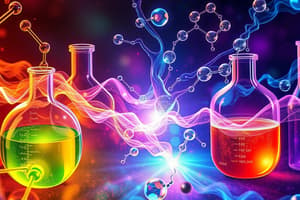Podcast
Questions and Answers
What is the chemical formula for Plaster of Paris?
What is the chemical formula for Plaster of Paris?
CaSO4.H2O
At what temperature is gypsum heated to form Plaster of Paris?
At what temperature is gypsum heated to form Plaster of Paris?
373 K
What happens to Plaster of Paris when it is mixed with water?
What happens to Plaster of Paris when it is mixed with water?
It reverts to gypsum, forming a hard solid mass.
Why is only half a water molecule represented in the formula for Plaster of Paris?
Why is only half a water molecule represented in the formula for Plaster of Paris?
List two applications of Plaster of Paris besides medical uses.
List two applications of Plaster of Paris besides medical uses.
What type of solid is formed when Plaster of Paris and water react?
What type of solid is formed when Plaster of Paris and water react?
Explain the importance of water of crystallization in the structure of Plaster of Paris.
Explain the importance of water of crystallization in the structure of Plaster of Paris.
What is the state of Plaster of Paris at room temperature?
What is the state of Plaster of Paris at room temperature?
Why is it important that Plaster of Paris hardens upon mixing with water?
Why is it important that Plaster of Paris hardens upon mixing with water?
What is the chemical reaction between Plaster of Paris and water?
What is the chemical reaction between Plaster of Paris and water?
Flashcards are hidden until you start studying
Study Notes
Acid-Base Chemistry
- Hydrogen ions (H+) are produced from hydrochloric acid (HCl) only in the presence of water, forming hydronium ions (H3O+) and chloride ions (Cl–).
- H+ ions must be represented as H+(aq) or as hydronium ions (H3O+) due to their inability to exist independently in aqueous solutions.
- Bases, when dissolved in water, generate hydroxide ions (OH–), with soluble bases referred to as alkalis.
Properties of Acids and Bases
- Common alkalis include sodium hydroxide (NaOH), potassium hydroxide (KOH), and magnesium hydroxide (Mg(OH)2).
- Alkalis are characterized by their soapy texture, bitter taste, and corrosiveness; caution is advised when handling them.
- The process of mixing an acid with water is called dilution, which reduces the concentration of acid in the solution.
pH Scale
- The pH scale measures hydrogen ion concentration in solutions, ranging from 0 (very acidic) to 14 (very alkaline).
- pH is derived from the German word ‘potenz’ meaning power, indicating the acidic or basic nature of a solution.
Biological Context
- The human stomach produces hydrochloric acid for digestion and discomfort during excess acid production can be alleviated using antacids, such as magnesium hydroxide.
- Tooth decay can start when the mouth's pH drops below 5.5, damaging tooth enamel and caused by bacterial acid production from sugars.
- Basic toothpaste helps neutralize excess acids, assisting in tooth decay prevention.
Chemical Properties and Reactions
- Nature provides neutralization mechanisms; for example, bee stings (acidic) and nettle stings (methanoic acid) cause pain, relieved by applying mild bases like baking soda.
- Salts produced from strong acids and strong bases are neutral (pH of 7), while those from strong acids and weak bases are acidic (pH < 7), and from strong bases and weak acids are basic (pH > 7).
Common Salt and Its Uses
- Sodium chloride (common salt) is produced from the reaction of hydrochloric acid with sodium hydroxide and serves as an important raw material for various chemicals.
- Through the chlor-alkali process, sodium chloride is converted into sodium hydroxide, releasing chlorine and hydrogen gases.
Plaster of Paris
- Plaster of Paris is created by heating gypsum, which loses water to form calcium sulfate hemihydrate (CaSO4·½H2O), and rehydrates to form solid gypsum upon mixing with water.
- It is widely employed in construction and medical fields.
Key Takeaways
- Acid-base indicators visually represent the presence of acids or bases in a solution.
- The acidic nature originates from the formation of hydrogen ions (H+(aq)), whereas the basic nature involves hydroxide ions (OH–).
Studying That Suits You
Use AI to generate personalized quizzes and flashcards to suit your learning preferences.




